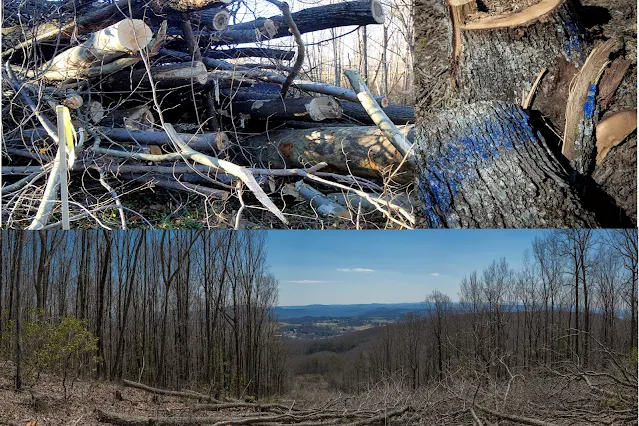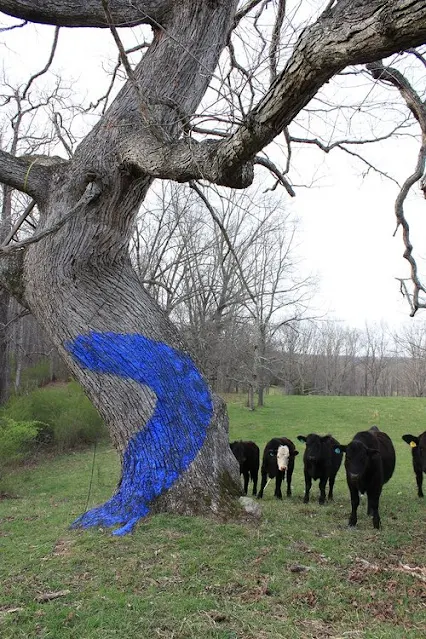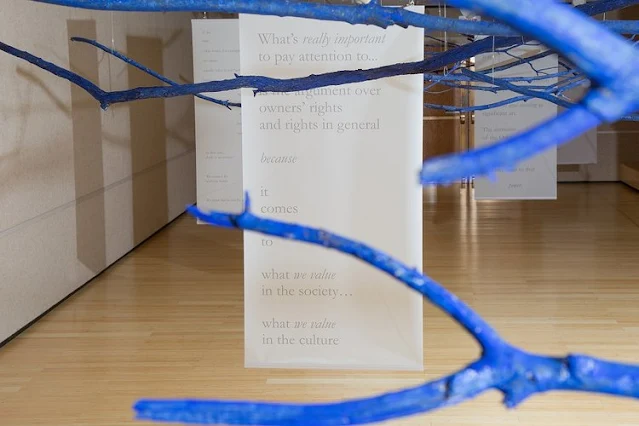Through Art, Industry, and Sound
Aviva
Rahmani’s visionary project Blued Trees transcends the boundaries of
conventional art to create an immersive experience that challenges perceptions
and redefines the relationship between nature and human intervention. In a
series of groundbreaking exhibitions, Rahmani transforms ordinary trees into
dynamic canvases of protest, weaving together visual splendor, industrial
critique, and musical storytelling to craft a dialogue that is as
intellectually provocative as it is emotionally stirring.
.jpg) |
| Aviva Rahmani - Blued Trees (Photo credit: www.avivarahmani.com) |
A Fusion of Art and Eco-Friendly Materials
At the core of Blued Trees lies an innovative artistic process that marries tradition with sustainability. The Ultramarine blue pigment, originally derived from ground lapis lazuli, is now synthesized (though non-toxic) and mixed with buttermilk to create a medium that is both environmentally friendly and rich in texture. This natural binder offers several distinct benefits:
Eco-Friendly and Biodegradable:
The use of buttermilk as a binder ensures that the medium is non-toxic and biodegradable, aligning with the environmental ethos of the project. Unlike synthetic chemicals, this natural combination minimizes ecological disruption while leaving no harmful residues behind.
Enhanced Adhesion and Durability:
Buttermilk, with its natural proteins and fats, acts as an effective adhesive that helps the blue pigment adhere firmly to the tree bark. This results in a finish that is resilient to the elements, allowing the artwork to endure over time and remain a persistent call to action.
Aesthetic and Textural Depth:
The blend creates a unique texture that enhances the visual impact of the blue sine waves. The natural, organic consistency of the mixture imparts a soft yet dynamic quality to the painted surfaces, echoing the subtle interplay between nature and human influence.
Cultural and Historical Resonance:
Using natural ingredients like buttermilk ties the project to historical art-making techniques, evoking a sense of tradition and authenticity. This approach reinforces the idea that our solutions to contemporary challenges can be inspired by the wisdom of the past.
Transforming
Trees into Living Symbols of Protest
At first
glance, the signature sweeping blue sine waves etched onto the trunks of trees
evoke an air of serene calm. Yet, beneath this familiar hue lies a message of
urgency, a deliberate, almost insistent reminder of nature’s fragility in the
face of environmental degradation. These blue lines are not mere aesthetic
choices; they are carefully calculated symbols of resistance. Each tree, reborn
as a living monument, speaks to the scars left by deforestation, pollution, and
unchecked industrial expansion. Rahmani’s intervention transforms a passive
landscape into a visual manifesto where nature itself takes on the role of
protester, urging onlookers to acknowledge the silent crisis unfolding in the
world around them.
Reimagining
Industrial Impact: The Metaphorical Gas Pipeline Dialogue
A particularly evocative aspect of the project involves a metaphorical dialogue between nature and industry. While the work never physically placed gas pipelines side by side with the painted trees, the juxtaposition is a well-taken observation. In fact, there are numerous images from one site where gas lines, disregarding legal pleas and injunctions, cut down trees with the sine waves still visible .
 |
| The Blued Trees Massacre (Photo credit: www.avivarahmani.com) |
This narrative uses the rigid,
invasive imagery of gas pipelines as a powerful metaphor for the cold,
mechanical forces of industrial exploitation that scar natural landscapes.
Moreover, each installation of painted trees is conceived as a “measure” within
a continental-scale symphony, emphasizing the idea of habitat contiguity and
the collective impact on our environment. This layered metaphor invites viewers
to reflect on the tension between industrial progress and the preservation of
our fragile ecosystems.
A
Symphony of Nature: Music Defined on a Staff
Rahmani’s exploration of the natural world does not stop at visual activism. In a daring expansion of her artistic narrative, another exhibition integrated a musical dimension that reimagined nature’s rhythms as a series of notes on a musical staff. In this installation, every brushstroke of blue was paralleled by a corresponding musical note, capturing the ambient symphony of the natural world.
.jpg) |
| The Blued Trees Symphony Measures and Sites (Photo credit: www.avivarahmani.com) |
The familiar soundscape of rustling leaves, distant bird calls, and the
whispering wind found a new form of expression on paper, as if the trees
themselves were singing an elegy for a wounded planet. This inventive blending
of visual art and music created a multisensory experience that resonated deeply
with audiences. The composition was not just an abstract overlay; it was a call
to listen, to the earth, to the voices of those impacted by environmental
neglect, and to the underlying harmony that binds all living things.
Layered
Meanings: Bridging Past, Present, and Future
The multifaceted nature of Blued Trees invites a reflection on the intricate interplay between memory and future potential. Every tree, marked with its sinuous blue line, becomes a storyteller. The work weaves together narratives of industrial encroachment with the timeless beauty of nature, suggesting that every mark on a tree is a record of human impact, a ledger of our collective environmental history.
This layered approach extends further when one considers
the additional installations, where elements like the metaphorical gas
pipelines and musical scores converge to highlight both the destruction wrought
by industrial systems and the hopeful potential for renewal. In these
interlaced narratives, there emerges a call for urgent reflection and
transformative action, a plea to honor the past while reimagining a sustainable
future.
An Ethic
of Place and the Call to Collective Responsibility
Central to Rahmani’s work is an ethos that insists our environment is not just a passive backdrop for human activity but a vital, living presence intertwined with cultural identity and personal memory. The Blued Trees installations encourage a deep connection with place, an invitation to see every natural element as part of a larger, interdependent system. The vivid blue lines serve as both a memorial and a beacon, urging communities to take collective responsibility for the stewardship of their local landscapes.
 |
| One Blued Tree (Photo credit: Robin Scully www.avivarahmani.com) |
In this context,
the work becomes a communal call to action, mobilizing not just art enthusiasts
but activists, policymakers, and everyday citizens who recognize that the
health of the environment is inextricably linked to the well-being of society.
Provoking
Thought, Inspiring Action
Rahmani’s
belief that “provocation without meaning is not art” finds full expression in
every aspect of Blued Trees. The installations are meticulously crafted
to provoke thoughtful dialogue rather than mere shock. By merging the tangible
reality of industrial encroachment with the ethereal beauty of musical scores,
the work challenges audiences to engage with the difficult questions of
environmental responsibility. It is an invitation to look beyond the
superficial and to consider the deeper implications of human progress, a call
to envision a future where art catalyzes real, positive change. In every sine
wave, every metaphorical reference to industrial intrusion, and every musical
note, there is a deliberate push toward reflection and, ultimately, action.
A
Resonant Global Dialogue
In an era
marked by unprecedented environmental challenges, the impact of Blued Trees
extends far beyond its physical installations. The project has sparked
conversations on a global scale, resonating with audiences from diverse
cultural and geographic backgrounds. Through media coverage, social media
discussions, and community events, the work has become a rallying point for
those advocating for environmental justice. The dialogue that Rahmani ignites
is both local and universal, addressing the specific concerns of industrial
encroachment and environmental degradation while also speaking to the broader,
shared responsibility of safeguarding our planet. This duality is what gives
the project its enduring power, transforming personal encounters with art into
a collective movement for change.
The
Creative Resistance
Ultimately,
Aviva Rahmani’s Blued Trees and its related installations stand as a
testament to the transformative power of art when it is deeply entwined with
purpose and activism. They remind viewers that every act of creative expression,
whether a sweeping brushstroke on a tree, a metaphorical reflection on gas
pipelines, or a carefully composed musical note—has the potential to challenge
established norms and inspire meaningful change. The project does more than
just depict environmental degradation; it redefines the role of art as an
active participant in the fight for sustainability and justice.
 |
| Coda VA Tech Blued Trees Installation detail #1 2016 (Photo credit: www.avivarahmani.com) |
In a world
where the threats to nature are mounting, Rahmani’s work offers both a mirror
and a roadmap: a mirror reflecting the current state of our environment and a
roadmap guiding us toward a future where art, industry, and nature coexist in a
more harmonious balance. Blued Trees stands as an enduring symbol of
resilience and hope, a vibrant call to protect, revere, and ultimately
transform the landscapes that sustain all life.
.jpg)


.jpg)







No comments:
Post a Comment